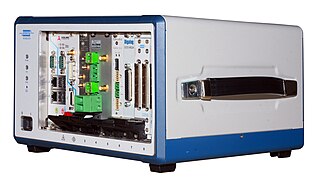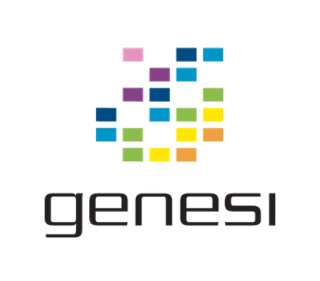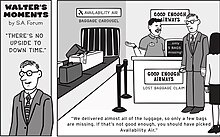
Open Firmware is a standard defining the interfaces of a computer firmware system, formerly endorsed by the Institute of Electrical and Electronics Engineers (IEEE). It originated at Sun Microsystems where it was known as OpenBoot, and has been used by multiple vendors including Sun, Apple, IBM and ARM.

Virtual Studio Technology (VST) is an audio plug-in software interface that integrates software synthesizers and effects units into digital audio workstations. VST and similar technologies use digital signal processing to simulate traditional recording studio hardware in software. Thousands of plugins exist, both commercial and freeware, and many audio applications support VST under license from its creator, Steinberg.

MontaVista Software is a company that develops embedded Linux system software, development tools, and related software. Its products are made for other corporations developing embedded systems such as automotive electronics, communications equipment, mobile phones, and other electronic devices and infrastructure.

Unified Extensible Firmware Interface is a specification that defines the architecture of the platform firmware used for booting the computer hardware and its interface for interaction with the operating system. Examples of firmware that implement the specification are AMI Aptio, Phoenix SecureCore, TianoCore EDK II, InsydeH2O. UEFI replaces the BIOS which was present in the boot ROM of all personal computers that are IBM PC compatible, although it can provide backwards compatibility with the BIOS using CSM booting. Intel developed the original Extensible Firmware Interface (EFI) specification. Some of the EFI's practices and data formats mirror those of Microsoft Windows. In 2005, UEFI deprecated EFI 1.10.
OpenMAX, often shortened as "OMX", is a non-proprietary and royalty-free cross-platform set of C-language programming interfaces. It provides abstractions for routines that are especially useful for processing of audio, video, and still images. It is intended for low power and embedded system devices that need to efficiently process large amounts of multimedia data in predictable ways, such as video codecs, graphics libraries, and other functions for video, image, audio, voice and speech.

PICMG, or PCI Industrial Computer Manufacturers Group, is a consortium of over 140 companies in the fields of computer science and engineering. Founded in 1994, the group was originally formed to adapt PCI technology for use in high-performance telecommunications, military, and industrial computing applications, but its work has grown to include newer technologies. PICMG currently focuses on developing and implementing specifications and guidelines for open standards–based computer architectures from a wide variety of interconnects.
Advanced Telecommunications Computing Architecture is the largest specification effort in the history of the PCI Industrial Computer Manufacturers Group (PICMG), with more than 100 companies participating. Known as AdvancedTCA, the official specification designation PICMG 3.x was ratified by the PICMG organization in December 2002. AdvancedTCA is targeted primarily to requirements for "carrier grade" communications equipment, but has recently expanded its reach into more ruggedized applications geared toward the military/aerospace industries as well. This series of specifications incorporates the latest trends in high speed interconnect technologies, next-generation processors, and improved Reliability, Availability and Serviceability (RAS).
Commercial-off-the-shelf or commercially available off-the-shelf (COTS) products are packaged or canned (ready-made) hardware or software, which are adapted aftermarket to the needs of the purchasing organization, rather than the commissioning of custom-made, or bespoke, solutions. A related term, Mil-COTS, refers to COTS products for use by the U.S. military.

PCI eXtensions for Instrumentation (PXI) is one of several modular electronic instrumentation platforms in current use. These platforms are used as a basis for building electronic test equipment, automation systems, and modular laboratory instruments.

In computing, an input–output memory management unit (IOMMU) is a memory management unit (MMU) connecting a direct-memory-access–capable (DMA-capable) I/O bus to the main memory. Like a traditional MMU, which translates CPU-visible virtual addresses to physical addresses, the IOMMU maps device-visible virtual addresses to physical addresses. Some units also provide memory protection from faulty or malicious devices.
The SCOPE Alliance was a non-profit and influential Network Equipment provider (NEP) industry group aimed at standardizing "carrier-grade" systems for telecom in the Information Age. The SCOPE Alliance was founded in January 2006 by a group of NEP's, including Alcatel, Ericsson, Motorola, NEC, Nokia, and Siemens. In 2007, it added significantly to its membership.
Communications servers are open, standards-based computing systems that operate as a carrier-grade common platform for a wide range of communications applications and allow equipment providers to add value at many levels of the system architecture.

Serial Digital Video Out (SDVO) is a proprietary Intel technology introduced with their 9xx-series of motherboard chipsets.

Genesi is an international group of technology and consulting companies in the United States, Mexico and Germany. It is most widely known for designing and manufacturing ARM architecture and Power ISA-based computing devices. The Genesi Group consists of Genesi USA Inc., Genesi Americas LLC, Genesi Europe UG, Red Efika, bPlan GmbH and the affiliated non-profit organization Power2People.
OpenSAF is an open-source service-orchestration system for automating computer application deployment, scaling, and management. OpenSAF is consistent with, and expands upon, Service Availability Forum (SAF) and SCOPE Alliance standards.
The Hardware Platform Interface (HPI) is an open specification that defines an application programming interface (API) for platform management of computer systems. The API supports tasks including reading temperature or voltage sensors built into a processor, configuring hardware registers, accessing system inventory information like model numbers and serial numbers, and performing more complex activities, such as upgrading system firmware or diagnosing system failures.

A computer cluster is a set of computers that work together so that they can be viewed as a single system. Unlike grid computers, computer clusters have each node set to perform the same task, controlled and scheduled by software. The newest manifestation of cluster computing is cloud computing.
PICMG 2.12 is a specification by PICMG that defines vendor-independent software interfaces for supporting control of the software and hardware connection processes. The specification was updated in May 2002 to add Windows and Linux updates, Redundant System Slot (RSS) API, switched PCI-PCI bridging support, hardware and O/S-independent models of network-connected intelligent nodes, standards-based management of HS- and RSS-capable CompactPCI platforms and IDSEL to global address (GA) mapping.
The Application Interface Specification (AIS) is a collection of open specifications that define the application programming interfaces (APIs) for high-availability application computer software. It is developed and published by the Service Availability Forum and made freely available. Besides reducing the complexity of high-availability applications and shortening development time, the specifications intended to ease the portability of applications between different middleware implementations and to admit third party developers to a field that was highly proprietary in the past.
OpenHPI is an open-source software system providing an abstracted interface to managing computer hardware, typically for chassis and rack based servers. It is production ready implementation of the Hardware Platform Interface specification from Service Availability Forum, complimenting existing hardware management standards. Founded in 2003, OpenHPI is maintained by the OpenHPI Project.











